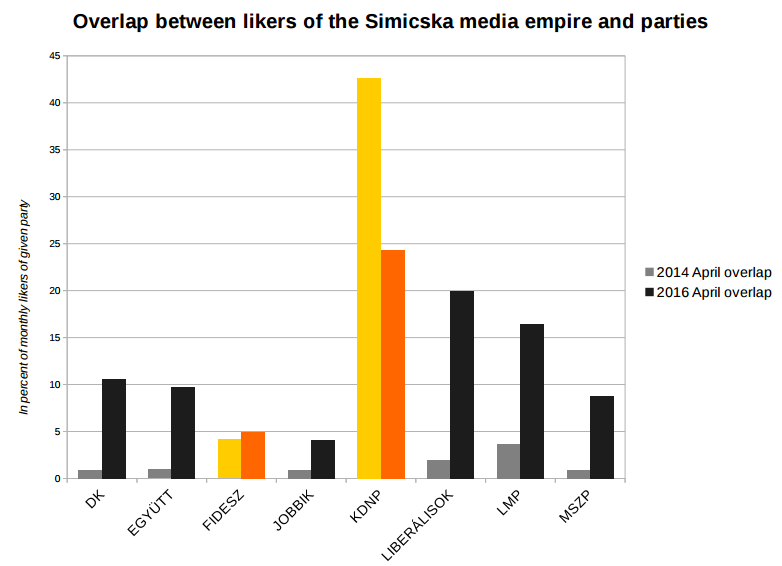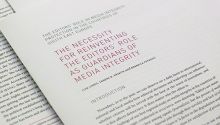“As I say, you can write it down, Orbán is a scum.”– verbatim words of Lajos Simicska, who eventually came out and commented to the Hungarian press why the editors-in-chief of his media empire committed a coup against Simicska in February 2015, which became known as the G-day (geci stands for scum in Hungarian). Ever since, the long-standing political bastions of the empire – HírTv, Lánchíd Rádió and daily Magyar Nemzet – became more and more critical to the governing Fidesz party. This paper aims to detect traits of this shift on Facebook. Our analysis in part indicates such shift in the user behaviour.
Simicska, the ex-cashier of Fidesz party entered the media scene after the lost elections in 2002 (On how Simicska lost a part of his media empire see article
here, and how the empire itself was used to extract public funds
here). The aim was to counterbalance the alleged left-liberal supremacy in the media, which according to the right-wing intelligentsia lead to loosing the elections. The Magyar Nemzet, the Lánchíd rádió and the HírTV were serving the interests of Fidesz along the right-wing political cleavage. When Fidesz came to power in 2010, the party was grateful: state advertisement funds arrived at these media outlets (while left-liberal media outlets were cut off from these funds). After the editors-in-chief and deputy editors-in-chiefs resigned from Magyar Nemzet, Lánchíd rádió and HírTv, the tone of these media outlets changed and from pro-government it became more and more critical to it and to Fidesz. Only anecdotal evidence suggested that the audiences of these three media outlets were unhappy with the changes.
Analysed dataset
The Fidesz–KDNP coalition is governing the country since the 2010 elections. The democratic opposition parties (DK, Együtt, the Liberals, MSZP) joined their forces for the 2014 elections, but they failed. LMP is the green party currently struggling with re-building its own structure. Jobbik is an extreme-right wing party trying to convert itself to a centrist.
In our analysis we have compared active supporters of the Facebook fanpages. By active supporters we mean people, who are liking content posted by the analysed fanpages in the analysed period. We have categorized the fanpages into several groups. Media outlets are categorized into left-wing media, right-wing media and Simicska media outlets (left and right-wing media outlets are included in the analysis as a control group). The parliamentary parties: DK, Együtt, Fidesz, Jobbik, KDNP, Liberals, LMP, and MSZP. From parties’ fanpages we have chosen the three most popular fanpages from the
previous research of Maven Seven. As the G-day was in February 2015, we have arbitrarily chosen April 2014 and April 2016 for the comparison.
 Shift in the audience
Shift in the audience
Firstly we were curious how the supporters – i.e. the “likers” of the posts of the analysed fanpages – changed over time. We had a look at the ratios – that is, if all likers of a party are considered 100 percent, then what percent of them also liked any posts of Simicska media outlets. The ratios between the Simicska-content-likers and likers for each party are given in the chart bellow. The chart (parties of the governing coalition are coloured in yellow) depicts that this ratio increased in case of almost all parties.
This impressive change can be explained by several factors – amongst others for instance that the content of HírTv and the others have changed, which can be observed in the change of the audience too.
This paper does not aim at controlling for everything. For instance we have not had a deep analysis of content published by the fanpages; we do not know how the reach of the fanpages have changed, etc. However, we also had a look at the overlap between the likers of the analysed Simicska fanpages between 2014 and 2016 and we have found that only ten percent of the 2016 likers were liking content on the same pages in 2014. For comparison, in case of Fidesz there was was 38 percent of same likers in both years.

Overlapping audiences
The page-page network is created based on how many people were liking posts of two connected fanpages in April 2014. There is an edge between two nodes if there was an overlapping audience between them – the thicker the edge, the larger this overlapping audience was. The node size reflects the unique likers, ie. those people, who were liking content just and only on the given fanpage. The node colour indicates the category of the fanpage, and the node shape whether the fanpages belongs to a party or to a media outlet.
Page-page network depicting the overlapping audiences in 2014
Page-page network depicting the overlapping audiences in 2016
The comparison of the two networks reveals that for 2016 the fanpages of Simicska-owned HírTv got in the middle of the cluster of the democratic opposition (consisting of DK, Együtt, the Liberals, MSZP) while its connections to the governing parties decreased. Lánchíd Rádió and HírTv remained closer to the governing coalition.
On the level of parties, the usual political cleavages can be seen: the well-connectedness of the governing Fidesz–KDNP; the outsiderness of the extreme right-wing Jobbik; and the fact that the democratic opposition shares the same audience. Among the party fanpages, that of Viktor Orbán and Fidesz are the most popular, followed by that of Jobbik.
Overlapping contents
We wanted to see what content caused the overlaps between the likers of the posts of the parties and of the Simicska media empire, that is, what topics triggered audiences. As it can be seen from the page-page network, HírTv has the largest overlap, in terms of number of likes to posts, with the parties of the democratic opposition. The following topics tackled these audiences in April 2016:
- Mária Sándor – a nurse who raised her voice against the detrimental situation of the healthcare organizing and participating in several protests;
- the referendum about the Sunday shopping and the abolition of this much-debated issue;
- Árpád Habony – a consultant to Viktor Orbán, who has no official role but the communication strategy of the governing Fidesz is connected to him, just as his luxurious life; and
- the infringement proceeding against the central bank.
This suggests that the likers of the content of the Simicska media empire are empathizing with several issues promoted by the democratic opposition.
We also had a look at what topics caused the overlaps between the Simicska media empire and the governing parties, and this actually was the meeting of Helmut Kohl and Viktor Orbán.
In sum, our small analysis indicates that there indeed was a shift in the audience of the partisan media outlets of Simicska. Due to the lack of data we cannot know whether this was caused by the G-day and the changed editorial policy or not. What seems certain is that there are topics, which are important for both the left- and the right-wing, like that or related to the health care and corruption.
It can also be added that the toolset of media effect theory researchers can be broadened with this new methodology, as with the analysis of the preferences of the online audiences one can understand political and social phenomena, and group dynamics better.
Limitations
Current research was not aiming at revealing spurious correlations. The results should not be generalized without a more comprehensive research. The data does not indicate how many people started following or left the fanpages, and are the same users active in 2014 and 2016, and how the reach of the fanpages have changed. For further research it would be worth to analyse longer periods of time in order to exclude seasonality, and of course more fanpages could be added to the analysis. In-depth analysis of the content that was published by the fanpages would provide more insights in the user behaviour.
The technology used in this research was powered by
Maven Seven, where the author is an analyst.








